10 December 2025
113145
19 min
4.54
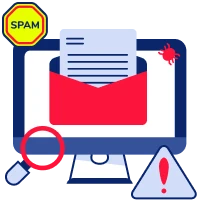
How to Check If Your Domain Is on a Spam Blacklist
Content
Email campaigns remain one of the most popular ways to communicate with your audience. Once you’ve built a substantial contact list, your next priority should be maintaining a strong sender reputation and avoiding email blacklists as well as IP blacklists that could result in you being blocked.
If you send emails daily or are just preparing to launch bulk email campaigns, it’s important to be well-prepared. The Yespo team created a comprehensive guide to help you gain a deeper understanding of building a good email sender reputation and avoid being listed on the spam email blacklist. But in this article, we’ll go even further.
Reasons Why Your Domain Can Be Blacklisted
Spam Complaints
The worst thing that can happen is getting blocked simply because recipients are repeatedly reporting your emails as uninteresting or inappropriate – essentially, marked as spam. Here are two common causes: you haven’t correctly set up Double Opt-In, or you forgot to include an unsubscribe link, forcing people to mark your emails as spam instead of simply opting out.
If you really want to communicate with your customers via email for a long time and effectively, it is highly recommended that they confirm their consent to receive emails. This is the easiest way to avoid being added to an email blacklist or an IP blacklist, and other undesirable consequences.
Your Domain Shares an IP Address With a Spam Sender
If it turns out that your domain or mail server uses a shared IP with a spammer (for example, if it is hosted together with other sites), there is a risk that the reputation of that IP will negatively affect your mailings.
Note
Email providers such as Gmail, Outlook, and Yahoo evaluate both IP and domain reputation.
Therefore, in the worst-case scenario, you may be marked as spam sender and blocked altogether.
To avoid this, responsible companies planning mass campaigns typically purchase a dedicated IP address. This allows them to control their reputation, avoid “crossing paths” with other users, and prevent being added to an IP blacklist due to third-party issues.
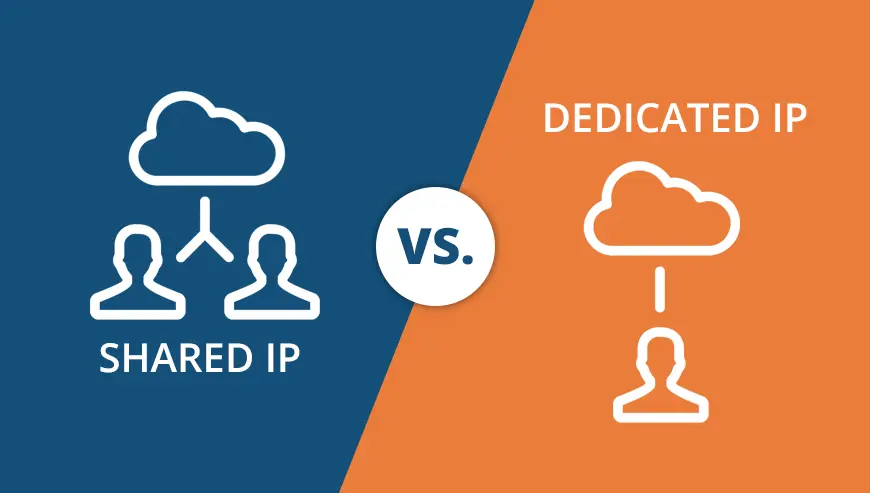
Unavailable Email Addresses
If you don’t use a DOI, your contact list can be full of non-existent addresses. Even if you collect your base the right way (by asking permission), validate it over time, and delete inactive contacts. Some of these addresses are no longer in use, and some may have been turned into spam traps.
As practice shows, this is one of the most common reasons for being added to an email blacklist. That’s why it’s strongly recommended to periodically “clean” your contact list using the services listed below.
Absent or Incorrect Digital Signatures
Email providers verify whether a message originates from your domain using special DNS records: SPF, DKIM, and DMARC. To ensure your emails pass these checks and are not marked as spam, it’s essential to configure all three records properly. Using them all together provides the highest level of trust from email services.
If any of these records are missing or misconfigured, attackers can spoof your domain and send spam on your behalf. This causes email providers to flag your legitimate messages as suspicious, increasing the risk of landing in spam folders or being blacklisted.
Want to stop worrying about blacklists and bounce rates?
Poor Subscriber Engagement
If your emails consistently show low opens, low clicks, or a high rate of “delete without reading,” mailbox providers view this as a sign of low trust. When poor engagement persists for an extended period, your domain may eventually be throttled, flagged, or even blocked.
IP Address Changes
Switching to a new server or purchasing a dedicated IP after running email campaigns for a while can significantly impact your sender reputation. If you rely on high daily email volumes, plan IP changes carefully to avoid deliverability drops.
Here’s what can happen:
- mailbox providers don’t know that the new IP belongs to you, so they initially treat it as “new” or “unknown”;
- if the IP address was previously used for spam, the system may immediately classify you as an unwanted sender and move it to an IP blacklist.
What should you do if circumstances force you to change your IP? You need to understand that, in most cases, your reputation will be “reset,” and you will need to:
- gradually increase your sending volume,
- verify that your DNS records (SPF, DKIM, DMARC) are correctly configured,
- monitor your deliverability performance;
- monitor IP blacklist status.
Sudden Spike in Sending Volume
If you think you can start sending thousands of emails at once – even to verified recipients – you’re making a serious mistake. Email providers will treat a sudden increase in sending volume from your domain or IP as suspicious activity and may add you to a blacklist.
Sharp spikes in email traffic look to filtering algorithms exactly like typical spammer behavior. When this happens, mailbox providers may:
- temporarily limit delivery;
- significantly reduce your domain’s trust score;
- send your messages to the spam folder;
- flag your IP or domain as potentially unsafe.
Infected or Compromised Systems
If your domain or server is hacked and begins sending spam or spoofed emails, especially with suspicious links, it can be added to an email blacklist almost instantly. In many cases, the sending IP address also ends up on an IP blacklist.
How to Remove Your Domain from a Blacklist
1. Identify the Blacklist You’ve Been Listed On
Run a domain spam check and confirm your IP reputation using several dedicated tools (a reasonably comprehensive list of services is provided in the next chapter below). Each email blacklist, as well as IP blacklist, has its own delisting policies, so it’s essential to know precisely which one flagged you.
2. Fix the Underlying Issue
Before submitting a delisting request, you must correct the issue that caused the block. This could include fixing authentication records (SPF, DKIM, DMARC), removing compromised accounts, or improving email engagement rates.
3. Submit a Delisting Request
Once the issue is addressed, visit the email blacklist’s / IP blacklist’s website and complete the delisting form. You will typically need to explain why you were listed, what corrective actions you’ve taken, and how you plan to prevent the problem from recurring.
4. Check Your Authentication Settings
After the delist, ensure all DNS records are configured correctly and use DNS lookups to double-check that SPF, DKIM, and DMARC are active and publicly accessible:
- SPF includes only the required IPs and services;
- DKIM signs all outgoing emails;
- DMARC is set to at least “none” (ideally, with a gradual transition to a strict policy).
5. Warm-Up Your Sending
Do not immediately return to large-scale email campaigns. Mailbox providers will continue to closely monitor your sending behavior for some time. To avoid problems, it’s essential to follow a gradual warm-up strategy:
- start with a small number of emails – first to your most engaged contacts;
- increase your sending volume step by step;
- maintain predictable sending patterns, as consistent small campaigns help build and strengthen your sender reputation.
6. Monitor Your Reputation Regularly
After being removed from the email blacklist, it’s essential to continually monitor spam complaint rates, email deliverability percentage, bounce rates, and user engagement.
Remember!
Most repeat blocks occur because senders return to previous mistakes, increasing the risk of being placed on an email blacklist or IP blacklist.
How to Avoid Being Blacklisted
To avoid constantly running a domain spam check to verify your status, start improving your sender reputation score from the very beginning – this significantly reduces the risk of your emails failing to reach the inbox.
Use a Verified and Authenticated Domain
From the outset, send emails from a “clean” domain. It is crucial to configure SPF, DKIM, and DMARC.
Warm Up Your IP/Domain
Select the most valuable segment of your contacts and start communicating with them first. Avoid sending multiple emails at once – sudden spikes can appear suspicious to mailbox providers. Increase your sending volume gradually and maintain consistent sending patterns.
Test Before Sending
Before sending out a mass email campaign, check your emails using deliverability and spam testing services to ensure they are effective. This will enable you to identify errors in advance and protect your sender reputation.
Add a Captcha to the Subscription Form
Such an addition to your form will protect you from bots that can submit large numbers of fake or low-quality email addresses. As a result, your email deliverability rates drop, your contact list becomes of low quality, and the risk of being added to an email or IP blacklist increases significantly.

Maintain a Clean Email List
If mailbox providers regularly see messages sent to inactive addresses, this damages your sender reputation and increases spam complaint rates. To avoid this,
- regularly clean the list, meaning delete inactive or incorrect addresses;
- use Double Opt-In to confirm the subscription.
Monitor Engagement
Maintaining a strong sender reputation means staying relevant to your audience. How do mailbox providers recognize this? Through metrics such as open rates, click-through rates, and bounce rates. Keep a close eye on these indicators, as well as spam complaints, to ensure smooth and uninterrupted communication with your audience.
Useful tip
To make your content helpful to readers:
- avoid overly aggressive sales tactics and spam;
- use personalization and a clear CTA;
- segment your audience and send them relevant content.
Minimize Spam Complaints – Add an Unsubscribe Link
If someone doesn’t want to receive your emails, what will they do? They’ll unsubscribe. But if they can’t find this option? Then the entire thread will end up in spam. To avoid this, place the unsubscribe link in a clearly visible spot in your email. This is also required by GDPR and CAN-SPAM regulations.
Monitor Email Blacklists and IP Blacklists
Regularly perform a domain spam check and use email blacklist checker services to check if your domain is blacklisted or if your IP is on an IP blacklist. If you find yourself blacklisted, follow the delisting steps immediately.
10 Best Email Blacklist Checkers
1. Spamhaus
It is a global DNS blacklist (DNSBL) database for IPs and domains. Spamhaus provides real-time email blacklist and IP blacklist status, along with automated domain spam check capabilities for email domain reputation monitoring. Its key advantages include:
- active use by major email providers,
- well-known worldwide, having been in operation for 27 years;
- instant detection of whether an IP or domain is blacklisted,
- server-level protection against spam.
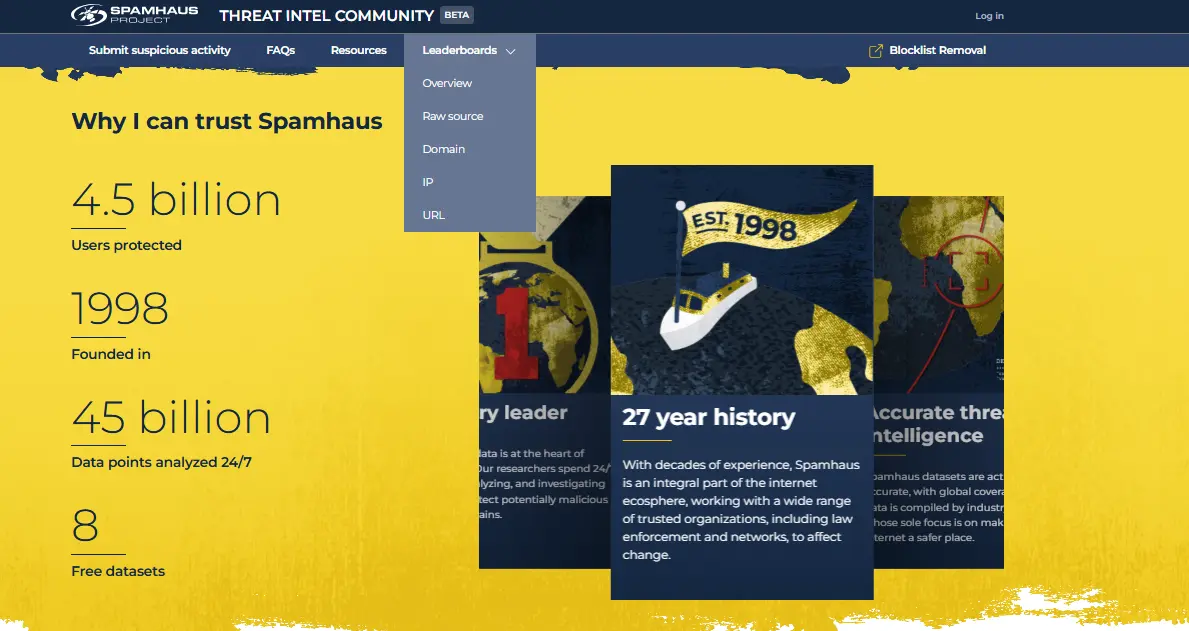
2. MXToolbox
This service enables you to check the reputation of IP addresses, monitor DNS records, and verify email blacklist status. And although the simple interface may be misleading, the service works reliably and offers several advantages, including:
- tools for monitoring SPF, DKIM, and DMARC;
- instant DNS scanning;
- a convenient dashboard for tracking IPs and domains;
- domain spam score verification;
- quick access to current IP address information in the bottom-left corner.

3. Zerobounce
A modern, user-friendly website with all the necessary functionality. It allows you to verify email addresses for validity easily. This is crucial for maintaining a good sender domain reputation and avoiding being listed on an email blacklist or IP blacklist. Among other things, the service can:
- detect non-existent, “dead,” and risky email addresses;
- protect against hard bounces;
- integrate with popular ESPs.
Advanced features include:
- providing additional information about a contact (geolocation, country, IP location);
- verifying emails without sending a message – using SMTP queries and DNS ping;
- identifying disposable (temporary) email addresses;
- detecting “spam traps” to prevent blacklisting.
4. EmailListVerify
A reliable email validation service focused on efficiency and simplicity. Key features include:
- bulk validation and fast verification of large lists;
- streamlined interface designed for quick list cleaning;
- straightforward API for easy integration.
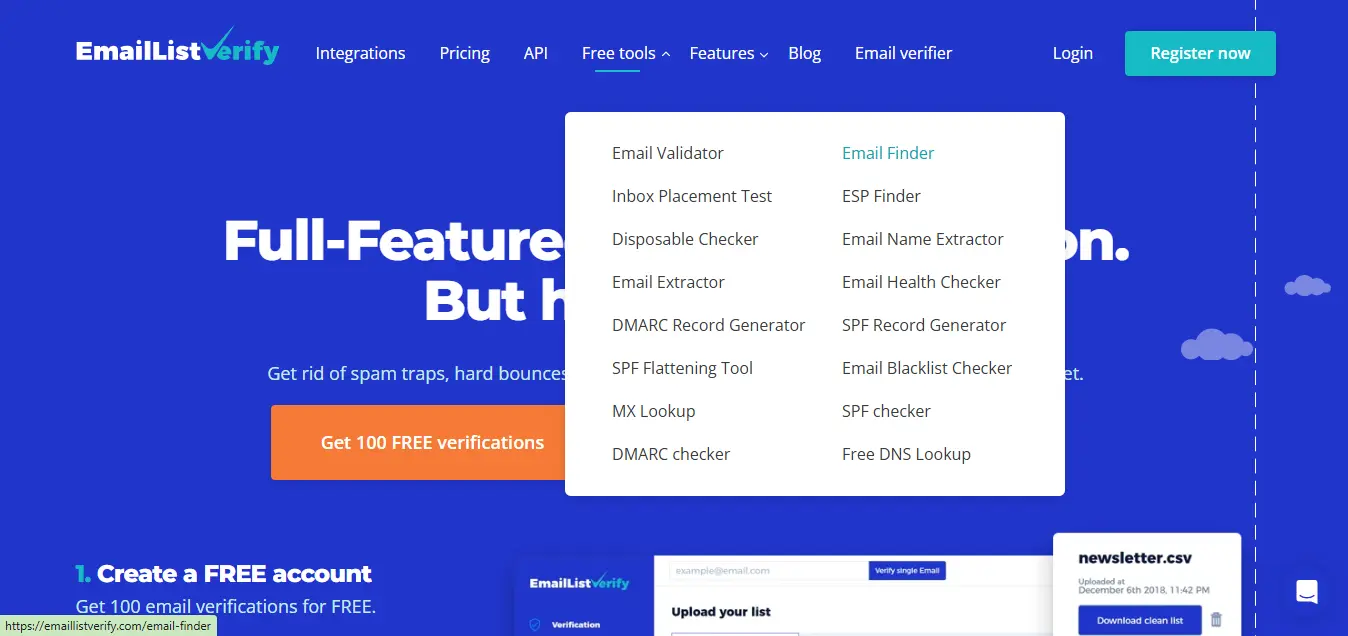
5. Mailtrap
Its wide range of features, integration options, and numerous articles comparing it with other niche services all indicate strong competitiveness and confidence. Unfortunately, the service does not provide a domain spam score, which can be very useful for quickly assessing the risk of your emails being marked as spam and optimizing email deliverability before sending campaigns.
Key features include:
- Email Sandbox for testing;
- Spam Checker;
- High-deliverability SMTP service;
- QA automation;
- Deliverability Alerts.
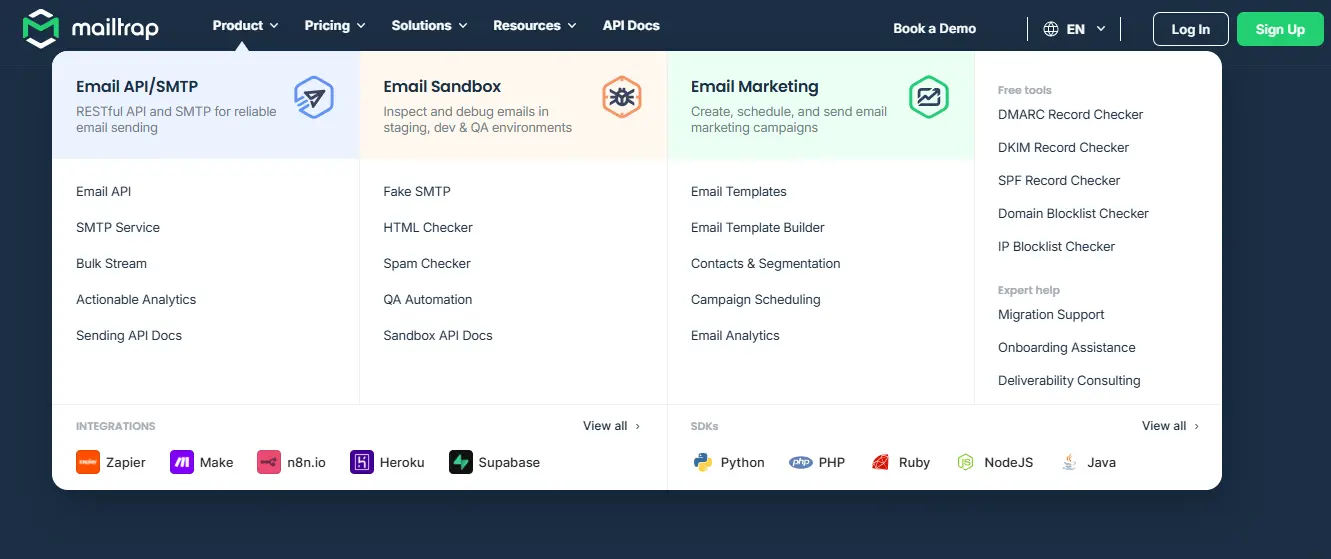
Here are the most valuable features of the service for marketers:
- support for teamwork, as you can create separate “boxes” for projects or environments within your personal account.
- detailed spam reports, as the system displays “triggers” and HTML rules that your email may violate, along with explanations for each point.
- built-in analytics and notification tools allow you to respond to reputation issues promptly, with the option to integrate into Slack;
- automated email testing, which is crucial for teams developing products or services that involve large-scale mailings.
I want to turn casual buyers into loyal brand fans
6. EasyDMARC
EasyDMARC helps monitor and improve your domain reputation by providing automated DMARC, SPF, and DKIM reports, protecting against phishing and spoofing, and alerting you to misconfigured records or unusual email traffic. It also allows you to check if your domain is marked as spam, helping prevent your domain from being blacklisted.
Key features:
- automatic reports on authentication issues;
- protection against phishing and spoofing;
- simple interface for policy management;
- ability to monitor email domain reputation and track IP blacklist and email blacklist status.
Key advantages of the service include:
- AI-powered analysis of DMARC reports;
- white-label interface and reports;
- alerts for incorrect records, failed authentications, or traffic anomalies.
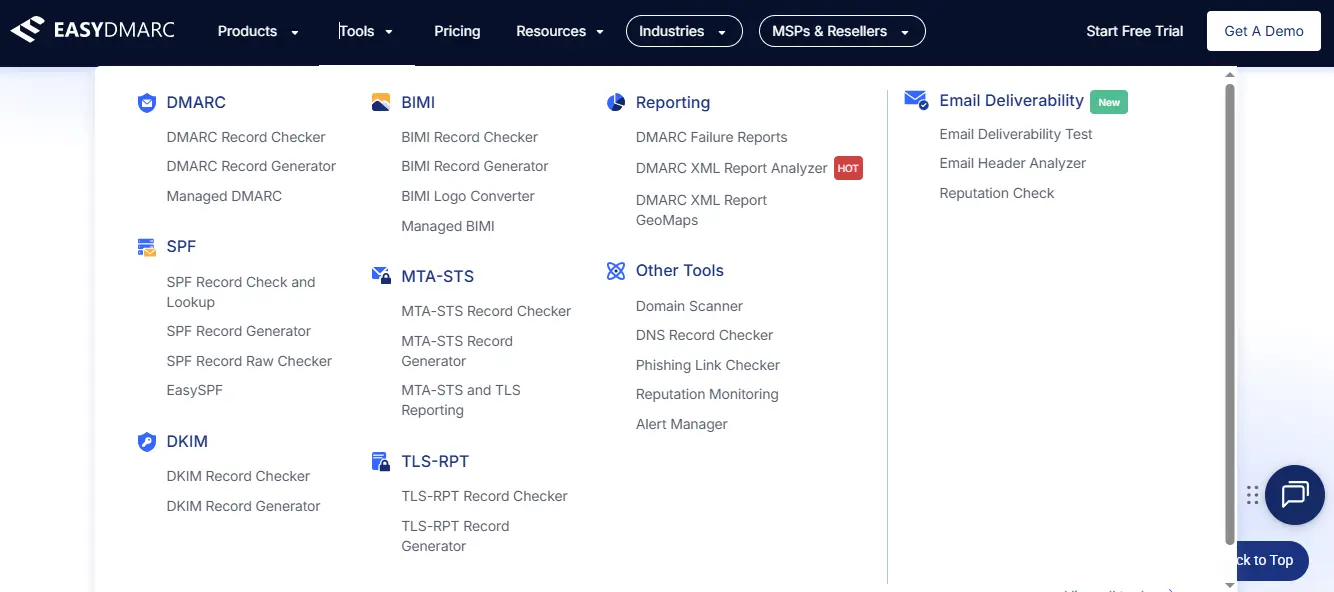
7. InboxAlly
The service specializes in ensuring emails reach the inbox rather than the spam folder. This is especially relevant for businesses that send large-scale email campaigns and work with multiple audience segments. New users can request a live demo before choosing and paying for a plan.
The platform’s standout feature is its built-in algorithms for automatically warming up a domain or IP, as well as simulating human engagement – opening, scrolling, clicking on emails, and more. You can adjust the intensity of the warm-up in the engagement profile.
Additional features include:
- recommendations on how to optimize email content to avoid spam filters;
- a dashboard with 30-day history, including metrics pulled from Google Postmaster Tools;
- inbox placement testing, where you can see exactly where emails land – the Inbox, the Promotions tab, or Spam;
- alerts for spam triggers and authentication issues (SPF/DKIM/DMARC)
- monitoring and insights for domain reputation.
8. InboxKit
A convenient service for checking email deliverability and spam levels. It is primarily aimed at sales teams sending cold emails. The platform claims a 95% inbox placement rate.
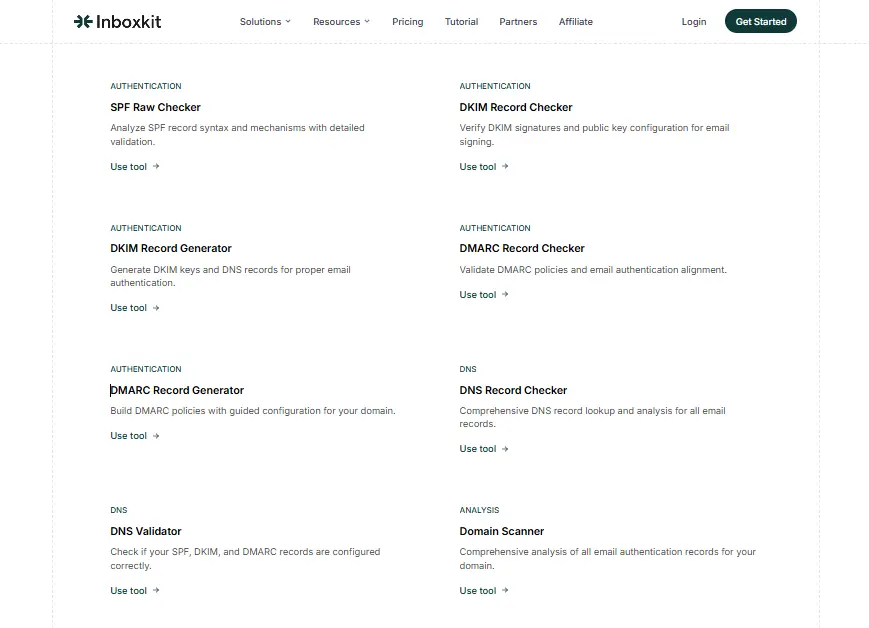
Key advantages of the service include:
- analysis of how emails appear across different email clients;
- detection of elements that may trigger spam filters;
- clear and user-friendly reports for marketers.
9. NoBounz
It positions itself as a professional email verification and list cleaning service. It enables you to quickly enhance the quality of your contact list without requiring manual work. This is especially useful if you have been using the same contact base for a long time, suspect declining quality, or want to reduce the risk of being added to an email blacklist or IP blacklist.
What you get:
- high-accuracy verification;
- fast processing of large lists;
- improved email deliverability rates;
- removal of spam traps from your contact list.
10. MailinBox
One of the most comprehensive services for email marketers, as it allows you to check domains and IPs for blacklist status and also resolve almost any issues related to email deliverability.
The platform offers intuitive navigation for monitoring sender reputation. Among the interesting features are:
- email blacklist monitoring;
- spam trap removal;
- support for multiple domains simultaneously;
- bounce testing;
- domain reputation monitoring;
- team account support.
Conclusion
Email service algorithms are fairly predictable, and with the right approach to sending, you can avoid landing on the email blacklist or IP blacklist. Even with a dedicated IP, keep your lists clean, prevent sudden spikes in domain activity, and properly warm up before launching large campaigns. It’s wise to periodically monitor your IP and domain using email blacklist checker tools to see if your domain was blacklisted. And if it happened, don’t panic – follow the step-by-step process: identify the issue, fix the root causes, and submit a delisting request.
To make marketers’ lives easier and help improve open rates and email deliverability, manage a domain reputation, we’ve compiled a list of highly useful resources. You’ll find guidance on improving content, as well as automated tools that help get your messages into users' inboxes.
We strongly recommend taking email communication seriously. Despite the proliferation of channels, email remains a top way to connect with your audience. On the Yespo platform, you can easily configure email templates – personal or built-in – set sending conditions, and review performance statistics. You can also embed email send scenarios into omnichannel workflows to broaden your communication reach and make it more personalized.

![What You Need to Know About Spam [Infographics] What A Markter Needs to Know About Spam](https://cdn.yespo.io/photos/shares/Blog/images/intro images en/spam-infographics.webp)
